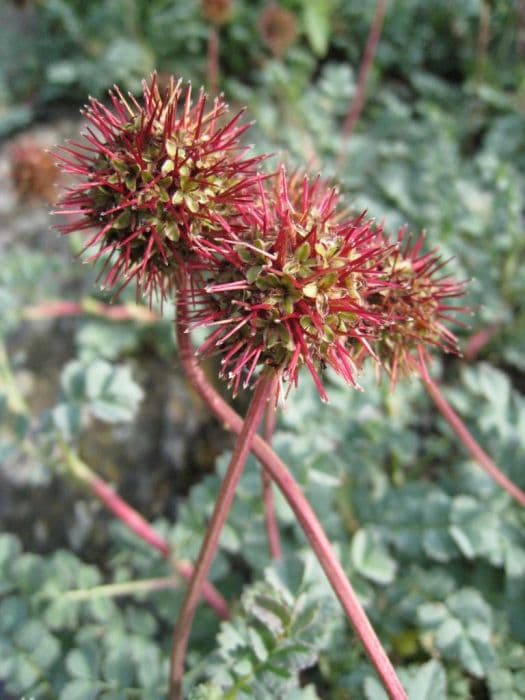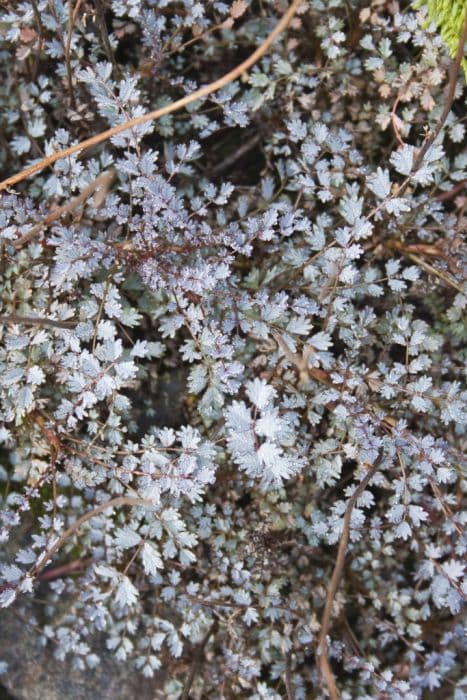Kathleen Harrop Rose Rosa 'Kathleen Harrop' (Bb)

ABOUT
The rose 'Kathleen Harrop' features a beautifully delicate appearance with a soft pink hue. The petals have a classic shape, forming a cupped blossom that invites onlookers to admire its form and perhaps catch a hint of its fragrance. Each flower emerges from a pointed bud, gradually unfurling its layers of petals as it blooms. The petals may show a slightly lighter color at the edges, providing a subtle contrast that enhances the flower's depth and dimension. The roses are borne atop sturdy stems, surrounded by lush, green foliage. The leaves have a glossy finish, which adds to the plant's overall vitality and vigorous appearance. The foliage forms a dense canopy, offering a brilliant backdrop for the rose's pastel blossoms. Overall, 'Kathleen Harrop' presents itself as an elegant shrub with a romantic allure, primarily due to its charming blooms that offer a timeless beauty to any garden setting.
About this plant
 Names
NamesFamily
Rosaceae
Synonyms
Kathleen Harrop Rose, Climbing Pink Rose
Common names
Rosa 'Kathleen Harrop'.
 Toxicity
ToxicityTo humans
Rose 'Kathleen Harrop' is not considered toxic to humans. While eating large quantities of any plant material may cause discomfort or digestive upset, roses, in general, do not contain toxins that are harmful to humans. Hence, accidental ingestion of parts of the rose plant typically does not lead to poisoning or serious health consequences.
To pets
Rose 'Kathleen Harrop' is also not toxic to pets. Roses are not listed among plants that are poisonous to dogs, cats, or other household animals. As with humans, ingesting roses might cause mild stomach upset in some pets but is unlikely to cause serious poisoning. That said, the thorns on rose plants can cause physical injury if not handled with care.
 Characteristics
CharacteristicsLife cycle
Perennials
Foliage type
Deciduous
Color of leaves
Green
Flower color
Pink
Height
4 feet (1.22 meters)
Spread
3 feet (0.91 meters)
Plant type
Shrub
Hardiness zones
Varies
Native area
Cultivar
Benefits
 General Benefits
General Benefits- Decorative Appeal: Adds an elegant aesthetic to gardens with its pastel pink blooms and lush green foliage.
- Aromatic Scent: The flowers have a light and pleasant fragrance that can enhance the sensory experience of a garden.
- Attracts Pollinators: Bees and butterflies are drawn to the blooms, aiding pollination of garden plants.
- Perennial Growth: As a perennial, it provides a lasting structure in the garden year after year.
- Low Maintenance: Requires minimal care once established, making it a convenient choice for busy gardeners.
- Climbing Habit: Can be trained to climb trellises and fences, adding vertical interest to gardening spaces.
- Drought Tolerance: Once established, it can tolerate periods of dryness, reducing the need for frequent watering.
- Adaptability: Capable of growing in various soil types, provided they are well-draining.
- Versatility: Suitable for mixed borders, rose gardens, and as stand-alone specimens.
 Medical Properties
Medical Properties- This plant is not used for medical purposes.
 Air-purifying Qualities
Air-purifying QualitiesThis plant is not specifically known for air purifying qualities.
 Other Uses
Other Uses- Rosa 'Kathleen Harrop' petals can be used in potpourri for their fragrance and to add a touch of color.
- The petals of the rose can serve as a natural dye source for fabrics, yielding delicate pinkish hues.
- Rosa 'Kathleen Harrop' can be used as a natural confetti at weddings or celebrations, being biodegradable and gentle to the environment.
- When dried, the rosebuds and petals can be incorporated into decorative wreaths and ornaments for a subtle floral touch.
- These roses can be pressed and used in personalizing stationary or creating unique bookmarks.
- The fragrant petals can be used in making homemade rose water, which is often used for cooking or baking.
- Rosa 'Kathleen Harrop' can be used in creating floral bath salts, providing a luxurious and soothing bath experience.
- The rose's sturdy canes can be fashioned into small rustic supports for indoor potted plants or for garden seedlings.
- Petals of Rosa 'Kathleen Harrop' can be frozen into ice cubes to add an elegant and colorful touch to drinks.
- The blooms can serve as a natural edible decoration for cakes and desserts when properly cleaned and ensured to be free of pesticides.
Interesting Facts
 Feng Shui
Feng ShuiRoses are commonly used in Feng Shui to attract love and create a calming atmosphere. They can be placed in the southwest area of the garden, which is associated with love and marriage, to enhance romantic relationships.
 Zodiac Sign Compitability
Zodiac Sign CompitabilityThe rose is not used in astrology practice.
 Plant Symbolism
Plant Symbolism- Love: As a variety of rose, Kathleen Harrop inherently symbolizes love. Roses are universally acknowledged as a flower that conveys deep affection and romantic love.
- Beauty: The rose's classic beauty makes it a symbol of aesthetic appeal. Kathleen Harrop, with its delicate blooms, emphasizes this symbolism.
- Femininity: Roses are often associated with femininity and elegance, and Kathleen Harrop, with its soft pink petals, underscores these qualities.
- Passion: While Kathleen Harrop is a lighter shade of rose, it still holds the symbolism of passion, indicative of deep emotional commitment and intense feelings.
- Secrets: Historically, roses have been used to symbolize secrecy. In Roman times, a rose hung above a meeting table meant that everything spoken was confidentially kept.
- Balance: The thorns and beautiful flowers on rose bushes are often seen as a symbol of balance between beauty and pain, highlighting life's contrasting elements.
- Honor: In certain cultures, giving a rose is a way to show respect or honor to someone, showcasing admiration for their achievements or virtues.
- Devotion: Roses often signify deep devotion and loyalty, whether between lovers, family members, or friends.
 Water
WaterFor the 'Kathleen Harrop' rose, also known as the bourbon rose, it's important to keep the soil evenly moist but not waterlogged. Water the rose about once a week with 1-2 gallons of water, but adjust according to weather conditions; more frequent watering may be necessary during hot, dry spells, and less when it's cool or rainy. Always water directly at the base of the plant to avoid wetting the foliage, which can lead to fungal diseases. During the winter months, reduce watering, but do not allow the soil to completely dry out.
 Light
LightThe 'Kathleen Harrop' rose thrives in full sun to partial shade. It should receive at least 6 hours of direct sunlight each day. An ideal spot is one that gets morning sunlight and some afternoon shade, especially in hotter climates to prevent stress from too much heat.
 Temperature
TemperatureThe 'Kathleen Harrop' rose prefers a temperate climate with temperatures ranging from 60°F to 75°F. It can survive minimum temperatures down to about 20°F but the ideal growing conditions are within the range specified. In areas with hot summer temperatures, it is important to ensure the rose isn't exposed to prolonged periods above 90°F.
 Pruning
PruningPrune the 'Kathleen Harrop' rose in late winter or early spring, before new growth starts. Remove dead or diseased wood, and thin out crowded areas to improve air circulation. Pruning encourages healthy growth and flower production. Repeat-flowering roses like this one can also be lightly pruned after each flush of blooms to maintain shape and encourage further flowering.
 Cleaning
CleaningAs needed
 Soil
SoilThe best soil mix for the Kathleen Harrop rose should be well-draining, fertile, and loamy with a pH range of 6.0 to 7.0. Amend the soil with organic compost and perlite to enhance drainage and fertility.
 Repotting
RepottingKathleen Harrop roses, being shrubs, are not typically repotted. They are outdoor plants that once established in the garden do not require repotting.
 Humidity & Misting
Humidity & MistingThe Kathleen Harrop rose thrives in average outdoor humidity levels; excessive humidity can lead to fungal diseases, so well-circulating air is beneficial.
 Suitable locations
Suitable locationsIndoor
Grow Kathleen Harrop rose indoor with bright light, good airflow.
Outdoor
Plant Kathleen Harrop rose in sun, rich soil, water deeply.
Hardiness zone
5-10 USDA
 Life cycle
Life cycleThe life cycle of Rosa 'Kathleen Harrop', commonly known as climbing rose, begins with seed germination, which requires stratification to break dormancy. Upon sprouting, the seedling develops roots and shoots, growing into a young plant. Vegetative growth proceeds as the plant matures, producing compound leaves, thorny stems, and developing a woody structure characteristic of shrubs. The climbing rose enters its reproductive phase, blooming in late spring to fall, showcasing fragrant pink flowers that attract pollinators for sexual reproduction. After pollination, the flowers develop into fruits known as hips, containing seeds that can be dispersed to start a new generation. The plant may eventually enter a period of dormancy in winter, reducing metabolic activity before resuming growth in the following spring.
 Propogation
PropogationPropogation time
Spring to Summer
Rosa 'Kathleen Harrop', also known as the Kathleen Harrop rose, is commonly propagated by softwood cuttings. The ideal time for taking cuttings is late spring or early summer when the new growth is still somewhat flexible. To propagate by this method, gardeners cut a piece of the stem about 6 to 8 inches long, making sure it has several leaves. The bottom end is dipped in rooting hormone for quicker root development, then the cutting is inserted into a soil mix that provides good drainage, such as a combination of peat and perlite or sand. The environment should be kept humid by covering the cutting with a plastic bag or placing it in a propagator, and it should be placed in indirect light until roots have developed, which generally takes a few weeks. Once rooted, the new Kathleen Harrop rose plant can be gradually acclimatized to outdoor conditions before planting out in the garden.









